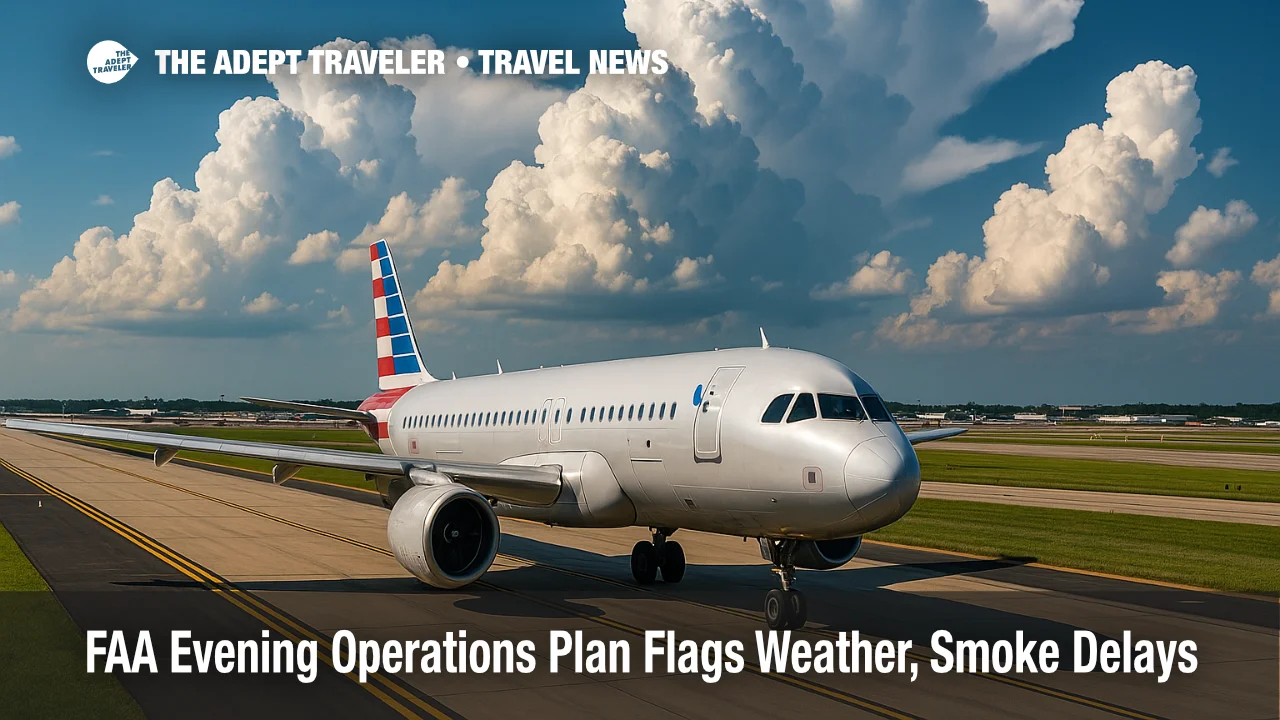FAA Evening Operations Plan Flags Weather, Smoke Delays

The FAA evening operations plan is flashing red for travelers on August 5. Thunderstorms threaten Atlanta, Charlotte and every major Florida hub, while wildfire smoke could slow departures at Denver and Las Vegas. Low clouds may even force a ground-stop at Seattle-Tacoma. Build extra buffer time between connections and know which lounges still have space before the crowds hit.
Key Points
- Why it matters: Storms and smoke raise nationwide flight delay alerts tonight.
- Travel impact: ATL, CLT, Florida hubs, DEN, LAS and SEA face the highest risk windows.
- What's next: Expect rolling travel disruptions and crowded lounges through late evening.
Snapshot
Severe summer weather is aligning with peak departure waves. The FAA warns of convective activity over the Southeast that typically slows arrival rates by up to 40 percent. Wildfire smoke from Western fires is drifting toward Denver International Airport (DEN) and Harry Reid International Airport (LAS), reducing visibility and triggering flow-control programs. Seattle-Tacoma International Airport (SEA) is seeing an early marine layer that could escalate to a ground-stop if ceilings drop below 500 feet. Check the National Airspace System dashboard or fly.faa.gov for real-time status.
Background
Summer afternoon thunderstorms are a routine hazard in the Southeast, but today's pattern is unusually broad, stretching from Hartsfield-Jackson Atlanta International Airport (ATL) through Charlotte Douglas International Airport (CLT) and into every major Florida hub: Miami International (MIA), Fort Lauderdale-Hollywood International (FLL), Orlando International (MCO), Palm Beach International (PBI) and Tampa International (TPA). At the same time, record wildfire activity in the Rockies and Mojave has pushed particulate smoke toward high-altitude jet routes, forcing Denver and Las Vegas controllers to slow departure rates. Low-level stratus off Puget Sound rounds out the trifecta, threatening SEA with instrument-flight restrictions.
Latest Developments
Flight Delay Alerts: ATL, CLT and Florida in the Crosshairs
The FAA evening operations plan, updated at 3 p.m. Eastern, projects ground-traffic-management programs for ATL beginning 6 p.m., with Charlotte following at 7 p.m. and staggered arrival-rate cuts at MIA, FLL, MCO, PBI and TPA through 10 p.m. Western en-route smoke may trigger a Miles-in-Trail restriction on westbound departures to DEN and LAS, potentially adding 45 minutes of taxi-out time. SEA tower has prepared a ground-stop script should ceilings fall below minimums after sunset. Travelers with tight layovers should rebook longer connections or pre-select re-routing options in their airline apps now to stay ahead of the queue.
Analysis
Tonight's alert highlights the fragile balance between capacity and demand in the National Airspace System. Thunderstorm-induced convective SIGMETS cut usable arrival slots at the busiest Southeastern hubs just as evening bank flights peak. Wildfire smoke layers add complexity by degrading climb-out visibility and requiring longer aircraft separation. The ripple effect extends far beyond the affected airports, as upstream crews and aircraft miss scheduled turns, triggering rolling delays and even cancellations country-wide. For travelers, the smartest strategy is to anticipate these travel disruptions: book nonstop where possible, choose earlier departures, and hold at least 90 minutes for connections through risk-flagged airports. Lounge crowding compounds the stress. A 2025 Airport Dimensions study found 66 percent of travelers feel terminals are more crowded, with 42 percent using lounges as an escape; demand spikes precisely when delays hit. Apps that display real-time lounge capacity or offer wait-lists are increasingly valuable tools for avoiding last-minute disappointment.
Final Thoughts
The FAA evening operations plan is an essential flight delay alert, and tonight it carries extra weight. By heeding the warnings, padding itineraries, and monitoring lounge crowding apps, travelers can blunt the impact of weather-driven travel disruptions. Stay flexible, stay informed, and you will arrive on time more often, even when the FAA evening operations plan sounds the alarm.
